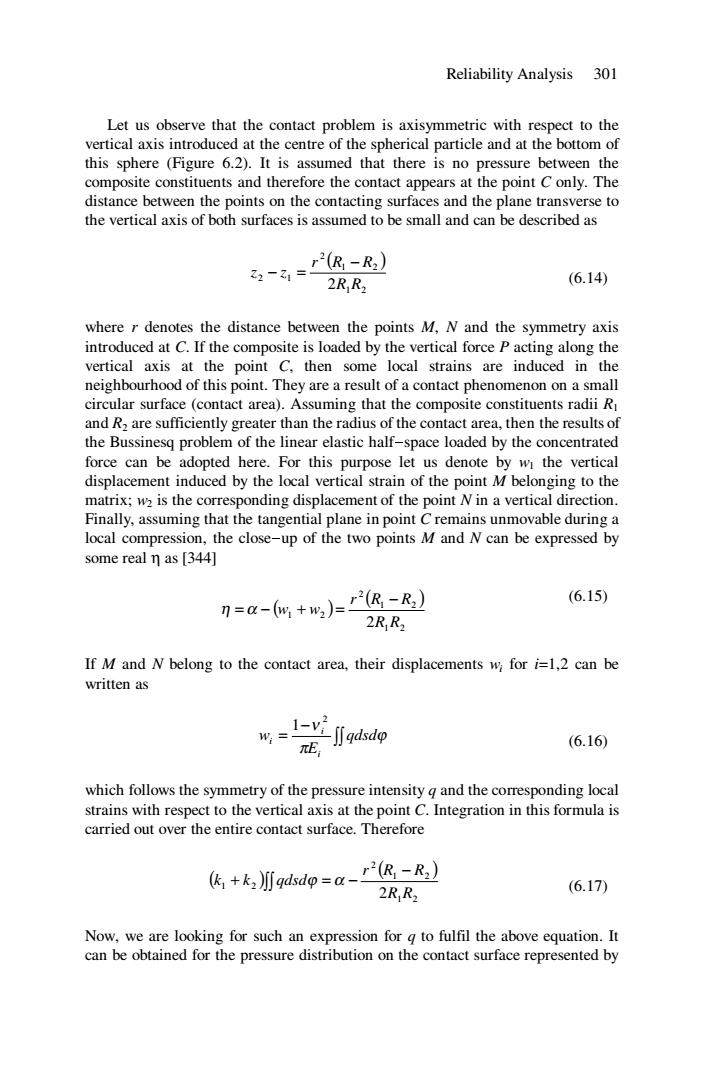正在加载图片...

Reliability Analysis 301 Let us observe that the contact problem is axisymmetric with respect to the vertical axis introduced at the centre of the spherical particle and at the bottom of this sphere (Figure 6.2).It is assumed that there is no pressure between the composite constituents and therefore the contact appears at the point C only.The distance between the points on the contacting surfaces and the plane transverse to the vertical axis of both surfaces is assumed to be small and can be described as 2(R-R2) 22-31= 2R R, (6.14) where r denotes the distance between the points M,N and the symmetry axis introduced at C.If the composite is loaded by the vertical force P acting along the vertical axis at the point C,then some local strains are induced in the neighbourhood of this point.They are a result of a contact phenomenon on a small circular surface (contact area).Assuming that the composite constituents radii R and R2 are sufficiently greater than the radius of the contact area,then the results of the Bussinesq problem of the linear elastic half-space loaded by the concentrated force can be adopted here.For this purpose let us denote by wi the vertical displacement induced by the local vertical strain of the point M belonging to the matrix;w2 is the corresponding displacement of the point N in a vertical direction. Finally,assuming that the tangential plane in point C remains unmovable during a local compression,the close-up of the two points M and N can be expressed by some real n as [344] 刀=a-6m+w,)=R-R) (6.15) 2RR2 If M and N belong to the contact area,their displacements w for i=1,2 can be written as =1x小gkd πE (6.16) which follows the symmetry of the pressure intensity q and the corresponding local strains with respect to the vertical axis at the point C.Integration in this formula is carried out over the entire contact surface.Therefore k+k川gddp=a-民-R) (6.17) Now,we are looking for such an expression for g to fulfil the above equation.It can be obtained for the pressure distribution on the contact surface represented byReliability Analysis 301 Let us observe that the contact problem is axisymmetric with respect to the vertical axis introduced at the centre of the spherical particle and at the bottom of this sphere (Figure 6.2). It is assumed that there is no pressure between the composite constituents and therefore the contact appears at the point C only. The distance between the points on the contacting surfaces and the plane transverse to the vertical axis of both surfaces is assumed to be small and can be described as ( ) 1 2 1 2 2 2 1 2R R r R R z z − − = (6.14) where r denotes the distance between the points M, N and the symmetry axis introduced at C. If the composite is loaded by the vertical force P acting along the vertical axis at the point C, then some local strains are induced in the neighbourhood of this point. They are a result of a contact phenomenon on a small circular surface (contact area). Assuming that the composite constituents radii R1 and R2 are sufficiently greater than the radius of the contact area, then the results of the Bussinesq problem of the linear elastic half-space loaded by the concentrated force can be adopted here. For this purpose let us denote by w1 the vertical displacement induced by the local vertical strain of the point M belonging to the matrix; w2 is the corresponding displacement of the point N in a vertical direction. Finally, assuming that the tangential plane in point C remains unmovable during a local compression, the close-up of the two points M and N can be expressed by some real η as [344] ( ) ( ) 1 2 1 2 2 1 2 2R R r R R w w − η = α − + = (6.15) If M and N belong to the contact area, their displacements wi for i=1,2 can be written as ∫∫ − = ϕ π ν qdsd E w i i i 2 1 (6.16) which follows the symmetry of the pressure intensity q and the corresponding local strains with respect to the vertical axis at the point C. Integration in this formula is carried out over the entire contact surface. Therefore ( ) ( ) 1 2 1 2 2 1 2 2R R r R R k k qdsd − + ∫∫ ϕ = α − (6.17) Now, we are looking for such an expression for q to fulfil the above equation. It can be obtained for the pressure distribution on the contact surface represented by